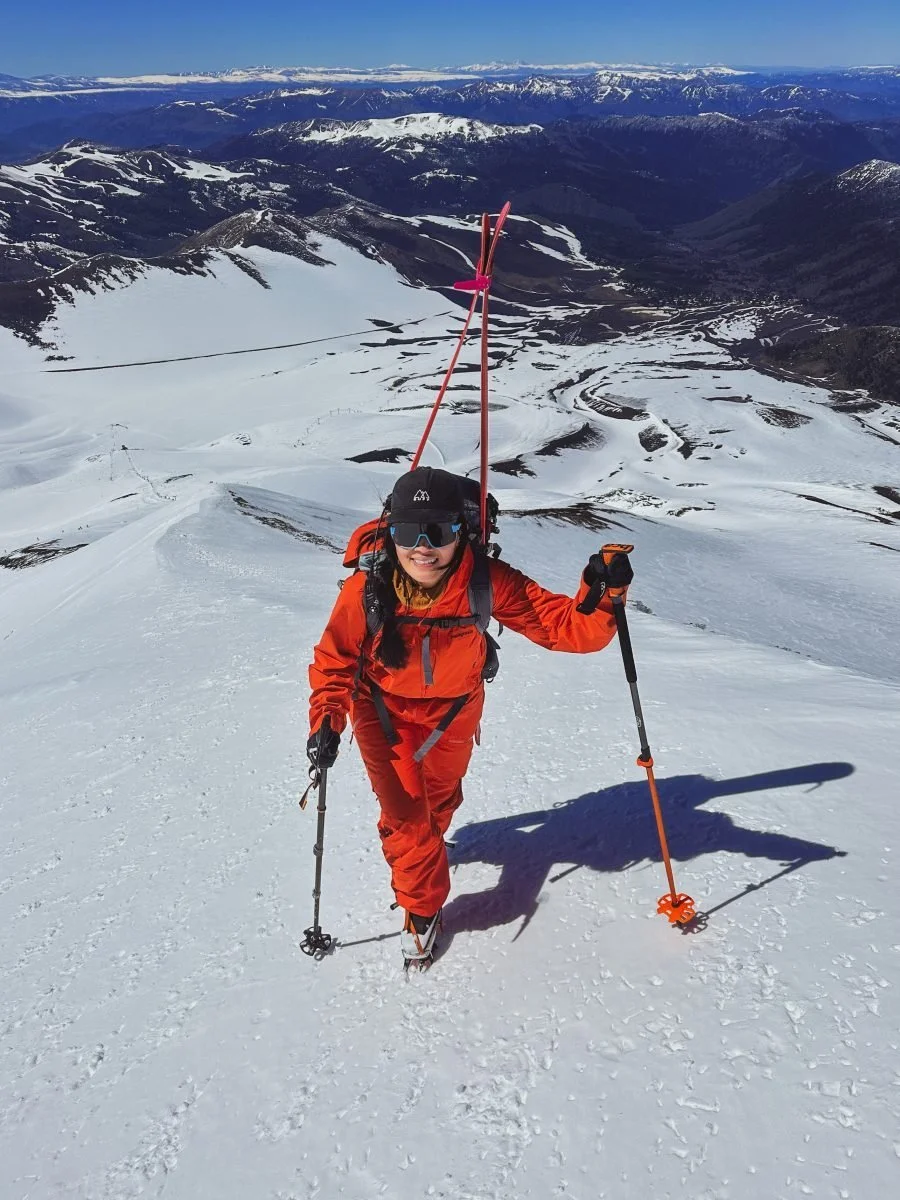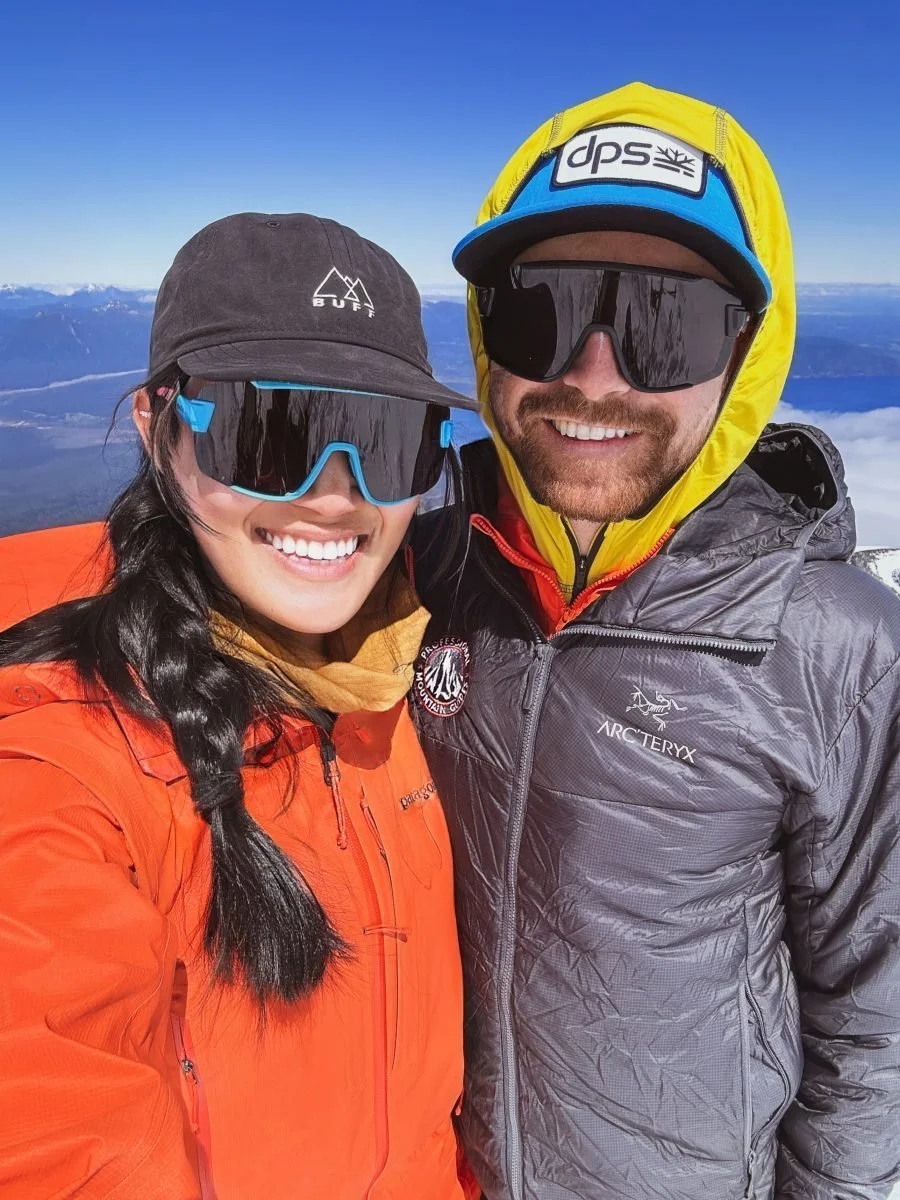Chasing Winter
This post was originally written for the Osprey blog. Osprey has so generously supported me and my outdoor endeavors over the last several years.
The wind whipped around my head, howling fiercely in the dim light. I barely heard Connor, my partner, who yelled “we should turn around!!” as he struggled to be heard over the 40mph winds ripping into us. We were stopped on what we presumed to be a ridgeline under the summit of Puyehue, a volcano in southern Chile, heads bowed in an attempt to escape the storm. The visibility that had been bad all day had somehow gotten worse, with the high winds and condensation creating a layer of rime outlining the brim of my helmet. I nodded back in response, stifling a groan at having come so close to the summit. But sometimes, Mother Nature has other ideas. As we prepared to turn around, all I could think was “How did I get here?”
Turns All Year
The answer begins on my first trip up Mount Adams in 2016, the second tallest peak in Washington state. Growing up in Texas, mountains were a completely foreign concept to me – something meant to be admired from a distance rather than experiencing intimately. I was brand new to mountaineering and had very little exposure to the backcountry. As we were climbing up, I watched skiers bring their gear up and whoop and holler in excitement skiing down from the summit. After deliriously slogging down the mountain the following spring in sloppy, hot, wet snow, I swore I would never climb it again if I couldn’t ski down it. Enter my obsession with TAY, short for “turns all year,” where snow enthusiasts challenge themselves to ski at least once a month, every month, come rain, snow, or storm.
I knew I had to vastly improve my ski skills to feel comfortable skiing in the backcountry year round, so that winter I dedicated my time to improving my skills at Alpental, my local ski hill. This allowed me to start connecting with the local outdoors community, and by extension, the local ski community. The more folks in the community I met, the more I learned about backcountry lines in the PNW, and the more excited I got about the prospect of skiing the volcanoes in Washington. I got my first taste of summer skiing in the PNW later that year, dragging my heavy alpine ski setup to the top of the Palmer Glacier on Mount Hood in August of 2017. We camped out under the stars and skied under a solar eclipse. It was a peak life experience and I knew I was hooked. I purchased my first backcountry ski setup two months later and started planning my adventures.
My first attempt at TAY started strong. I made it 11 months before neglecting to ski a month, resetting my clock but with new experience under my belt. I immediately restarted my streak the following month, September 2018 and have been going strong since!
The quest for skiable snow is not without its struggles, voluntary as they may be. In winter months, the ski areas are open. It doesn’t matter if you’re skiing groomers or ripping off piste in the side and backcountry of your favorite resort–it all counts. In the spring, it’s relatively easy to get to the snow line without too much walking. An added bonus of spring in the PNW is that it’s the best time to ski stunning volcanoes which make for some incredible continuous 5,000ft+ ski descents. Late summers/early autumns prove to be more difficult in the search for turns. There’s always the reliable Muir Snowfield on Mount Rainier or the Palmer Glacier on Mount Hood, but it’s always a good time to take the opportunity to explore some farther flung, hard-earned snow patches.
On the worst days of TAY, when the snow never firms up, the walk before ever getting to put on skins is long, and all of your friends are doing more seasonally appropriate activities like trail running, rock climbing, or mountain biking, the TAY community keeps me going. If you’ve visited the Paradise parking lot at Mount Rainier National Park in Washington state, you’ve likely seen fellow TAYers bonding over questions like “Where did you go skiing?” and “How do you get up there?” Visitors to the park watch in equal parts horror and amusement as we slog up and back down from the Muir Snowfield, making our annual summer pilgrimages to earn our turns. After, you might find us in the parking lot–grilling burgers and kicking back with friends and new acquaintances to share snacks, stories, and plan the next round of adventures.
October in Washington isn’t the most inspiring place to be, as it’s the beginning of the rainy season – limiting many outdoor activities. The snow lines are still too high for frequent skiing, but the abundance of rain down low makes it uninspiring to do more than cozy up on the couch. I normally head to the desert for a couple of weeks during this time to escape the rain and keep weekends available to go up Rainier. In planning for my October vacation this year, my partner, who, quite understandably, chooses not to participate in TAY, suggested that I explore options in the southern hemisphere to find spring skiing.
Celebrating 50 Consecutive Months
And so, for my 50th month in a row of earning my turns, I found myself shivering against the gusts of wind just under the summit of Puyehue in Chile, ready to call it on the summit. Connor and I downclimbed fifty feet and found some shelter from the wind under a chunk of ice. We took the skis off of our packs and transitioned to skiing, slowly following our bootpack and skin track up since there were no other reference points for us to navigate the terrain by as we skied through the thick clouds. The snow was incredibly light and fluffy, but visibility was abysmal and we were unable to see more than ten feet ahead of us on our way down. To plan our route and objective, we consult with resources such as Gaia GPS, Fatmap, and Google Earth to familiarize ourselves with the terrain before we head out. We also check our local avalanche forecasts, have avalanche education (in this case, Connor is also a mountain guide and an avalanche instructor himself), and check weather forecasts so we know what we might get ourselves into. But sometimes, weather moves in and we just have to make sure we’re prepared to tackle the objective even in marginal conditions.
That was our first ski day of our two week trip. It continued to rain for the bulk of our vacation, and while we took advantage of the few sunny days we were given, we spent a lot of that trip hunkered down indoors from the storms.
By our last day in Chile, we were feeling pretty defeated by the bad weather that we experienced for the majority of our trip. After all, the whole purpose of the vacation was to ski as much as possible for my 50th month. We looked at the marginal weather forecast one last time and decided that we should go try to ski one last time, since it would be our last opportunity before heading home. The day turned out to be the best ski day we had on the entire trip. It was mostly sunny and warm the entire day up to the last few hundred feet when a cloud rolled, dropping temps enough to turn the summit into an icy mess.
We spent some time on the summit, taking in the views and basking in the beauty and crossing our fingers for the clouds to clear before it was time to transition for the downhill. Our skis chattered down the thick rime for a few hundred knee-aching feet but soon we found soft buttery snow for our final turns of the trip. Connor and I both shouted with joy, those hard-earned turns making everything worth it.
This trip was the perfect metaphor for embarking on the TAY journey. Some of it is a fun experience but other times, as many friends say, “you don’t know until you go.” Earning your turns isn’t about finding the best turns or sometimes it’s not even that fun; it’s more of an opportunity to check out new places, suffer a little bit, and look back in retrospect at how iconic crying up a certain peak or being scared out of your mind down a line in the middle of August can be.
I originally started turns all year because, being new to the PNW, I thought it was a novelty to be able to ski every month of the year. I thought I’d try it out for one year just to have done it once. But that one year became two, then four. At this point I have no plans to stop. September and October usually make me want to quit, but then I push past it to November and then it becomes fun again. Would I recommend it for everyone? Not necessarily. But it has provided me a unique way of forcing myself to get out on days I might not necessarily care to be out skiing, exploring new places, and most importantly, connecting with a community.
If starting TAY is something that piques your interest, here are a few tips I have to get started.
Training and Education
While you can do several months of TAY in the controlled environment of a resort, the off-season months will require backcountry travel.
Ski inbounds as much as possible on different types of terrain before venturing out into the backcountry. Ski proficiency is extremely important for your own safety and for others you are recreating with.
Take an avalanche education course and get the appropriate gear.
Friendships, Mentorships, and Community
Turns All Year is only fun when you have a community of those who do it as well. It also holds you accountable to keeping the streak alive and coming up with creative ways to do so.
Learn from others who have done it for longer and get inspired by the trips they have taken.
Friendships in the community help push past the mental blocks when August rolls around. It’s way more fun to be slogging up a mountain on a hot summer day with friends instead of tackling the challenges alone.
Planning
Some months are easier than others and all you have to do is hop on a lift. Other months are more challenging and it’s useful to have go-to places planned out in advance as you wait for weather windows to allow you to accomplish the turns for the month.






